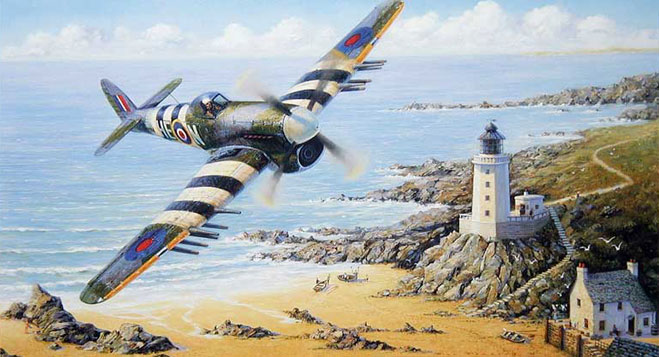
'Typhoon!'
A 263 Sqn Typhoon over the Cornish Coast

Still bearing the distinctive black and white ‘invasion stripes’ that have become so familiar since their hurried application weeks earlier, a lone 263 Sqn Typhoon crosses the North Cornwall coast en-route to its base at Bolt Head............
Between the 3rd and 5th June 1944 the majority of allied aircraft were painted with the now famous identification markings, in preparation for D-day. Previous experiences had shown that aircraft losses to friendly fire were all too likely during such a massive operation, with the Typhoon being especially prone due to its superficial likeness to the Focke Wulf 190.
One of only two Typhoon squadrons to remain as part of Fighter Command (temporarily renamed Air Defence of Great Britain), 263 Sqn, code-letters HE, was unusual in that it had two flights, one operating as bombers and the other armed with rockets. Based at Harrowbeer during the invasion they moved to Bolt Head, Devon on the 19th June 1944.
Photographs of the period show 263 Sqn identification markings as somewhat variable with instances of the code letters before and after the aircraft letter. Although in most cases it was the latter, out of purely personal preference I have opted for the former.
Although not as heavily defended as the more vulnerable southern beaches, the north coast of Devon and Cornwall received a certain amount of fortification with pill-boxes, scaffolding and barbed wire springing up as 'fortification fever' gripped Britain in the early years of the war. In some places however, enthusiasm seems to have got the better of common sense for there are tales of huge barricades being erected across unmade paths leading down to the smallest of coves, many of these obstructions being subsequently removed after pressure from the villagers.
Nature also seems to have raised the occasional objection. A local man recalled a great line of concrete blocks known as 'Dragon's Teeth' being built across the beach at Chapel Porth - only to be washed away in the winter storms of 1940-41.
Following the Normandy landings many English coastal areas slowly returned to normal. Visiting restrictions on the South Coast were lifted and the inhabitants of villages around Slapton Sands, who had been evacuated when the area became an invasion training ground, were allowed to return.
The handful of people who inhabit this painting have been little troubled by such things. The narrow road down to the cove is easily defended, and the beach is naturally obstructed by rocks, with any man-made fortifications having long gone the way of those at Chapel Porth.
To the battle weary pilot of the Typhoon it is an idyllic scene, and no doubt he casts an envious glance in the direction of the fishermen who are about to augment their rations with freshly caught crab. Or has something else caught his eye?
For all enquiries regarding these prints please contact:
Bill Perring
D'Arcy Collection
8 Marlpit Lane
Coulsdon
Surrey
CR5 2HB
Tel: 01737 555727